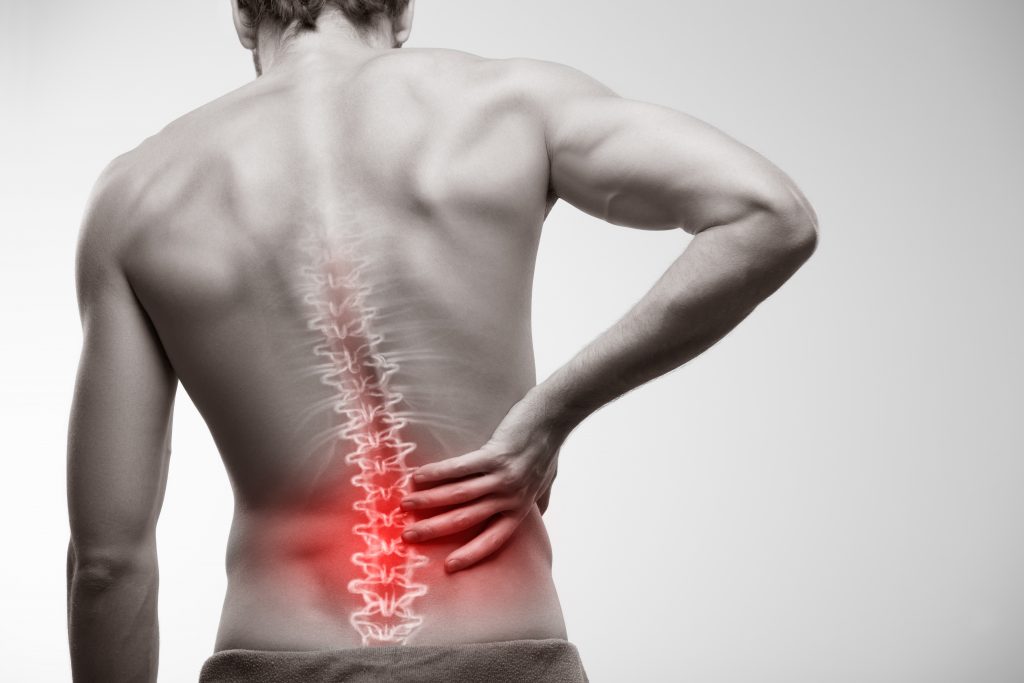Lower back pain is one of the most common health problems. It creates a substantial personal, community, and financial burden. The National Institute of Neurological Disorders and Stroke suggest that 80% of people will suffer from back pain at some point in their lives. It is said to be most common in females aged 40-80 (Hoy et al., 2012). There are many reasons as to why lower back pain can crop up. This post covers the causes, treatments, and prevention of the various types of lower back pain.
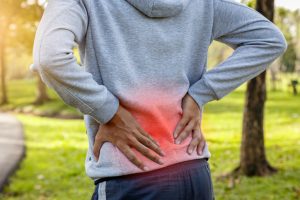
Anatomy and Structure of the Back
Your lower back, also known as your lumbar spine, consists of your lumbar vertebrae L1-L5. These vertebrae are much heavier than the other parts of your spine. The lumbar area of your spine typically curves inwards. This is a natural curve that everyone has and is called lordosis.
Large muscle groups that support your spine help with stability and controlled movements of the trunk. Some of your main muscles include the erector spinae and multifidus, which act as your back extensors. Alongside these, the obliques and rectus abdominus aid flexion and rotation. Strains and sprains in these muscles are the reason why many people experience lower back pain.
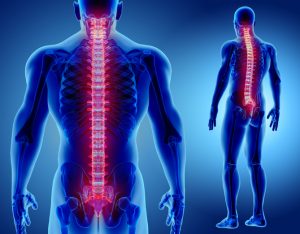
As well as these muscles, facet joints help connect your vertebrae to your spine. These are responsible for movements such as extension in the back. In between each vertebra are your intervertebral discs, which act as a cushion between each vertebra and provide some shock absorption.
Symptoms of Lower Back Pain
Your symptoms can determine what type of back pain you are suffering from. It’s important to know the difference between delayed onset muscle soreness from the gym (DOMS) and pain from a condition or injury.
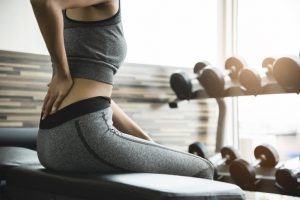
Usually, DOMS will settle over 48 hours and just be sore around the area that you trained (NHS, 2017). However, some pain can last longer. If your lower back pain lasts longer than 48 hours, and you’re starting to experience leg pain alongside it, then this is a sign that you have an injury.
Types of Lower Back Pain
The NICE guidelines (2016) suggest that lower back pain causes more disability than any other health condition. The guidelines state that episodes of lower back pain don’t typically last very long, and quick improvements are seen within the first few weeks to months.
There are various types of lower back pain, varying in severity. So to help you diagnose yours, I’ve listed the different types.
Non-Specific Lower Back Pain
This refers to when the pain is not related to any underlying disease. It is most commonly known as a sprain or an over-stretch. Approximately 90% of lower back pain falls under this category (Koes et al., 2006).
Lower Back Pain with Leg Symptoms
This type of pain is usually felt in the lumbar area. As well as lower back pain, you might suffer from leg pain/symptoms as well. Leg symptoms include pins and needles that radiate down into the toes. Alongside this, you might also feel a burning sensation down the leg. This indicates that there is some nerve involvement.
Serious Spinal Pathology
If you start to notice any symptoms relating to sudden loss of bladder and bowel control, or sensation in the groin area, this could indicate a serious spinal pathology. This type of lower back pain needs medical attention immediately. These symptoms combined with bilateral pins and needles or unremitting night sweats are a cause for concern.
What Causes Lower Back Pain?
There isn’t one specific cause to all lower back pain, and each person’s anatomy is different. But most of the time, lower back pain isn’t caused by anything serious. Awkward bending or lifting something ineptly is a common cause. Because this puts stress on the muscles around the lower back area, sprains often happen as a result.
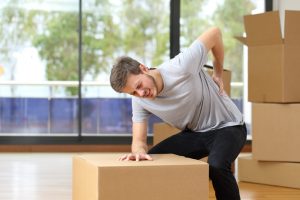
Risk Factors
The three most significant risk factors that leave you susceptible to lower back pain are:
- Being overweight
- Lifting heavy things and overloading the back
- A sedentary lifestyle
NICE (2016), suggest that one of the greatest challenges with lower back pain is identifying risk factors. These can lead to chronic re-occurrence of symptoms. Some risk factors are more difficult to spot. These can include stress, anxiety, depression, whole-body vibration and low levels of social support.
Tips to Prevent Lower Back Pain
If your current job involves lifting or loading of the spine, including twisting movements, this can elicit lower back pain. Make sure you lift things correctly, using a squat stance rather than bending at the hip. Carrying heavy bags on one shoulder can also put a strain on your back. Instead, try wearing a backpack to ensure the weight is evenly spread.
Lifting heavy weights in the gym has a long-term impact on your joints, which in time will degenerate. It has the same effect as being overweight. Prolonged heavy lifting can cause your lower back to become sore and inflamed. If you feel lower back pain, this is a sign you need a rest. If you like to lift heavy in your workouts, make sure to periodise your training. Take a week off heavy lifting every few weeks to give your joints a break. During this time, try some gentler rehabilitative exercise. Yoga and pilates are fantastic for movement in the back as well as building up your trunk muscles for stability.

On the other hand, if you have a desk-based job involving sitting for long periods, this can also bring on lower back pain. Our backs like to be mobile and kept moving. So if we don’t allow movement in the back, we end up with stiff joints. Try getting up every hour to stretch and have a walk around the office.
Treatment for Lower Back Pain
If you’re suffering from lower back pain, the most important thing is to ensure you keep yourself moving. Try and stay as active as possible, as keeping your body in one position for too long can make your pain far worse. Gentle exercise for your back is essential to aid recovery and prevent a reoccurrence. Alongside this, exercises that strengthen the core will help to build stability for your lower back. So, I’ve listed some of the best movements to help improve back pain below:
- Bridging: not only will this help to build your core to stabilise your back, but it will also help with your motor control.
- Pelvic tilts: bringing your pelvis into anterior and posterior tilt will help to encourage movement from the lumbar area.
- ‘Happy/angry cat’ stretch: this is also very good for encouraging movement in the back, and will help to alleviate some of your symptoms.
- Plank holds: this will build the core and strengthen the trunk area.

Getting adequate pain relief is key to aid rehabilitation. For non-specific lower back pain, over the counter medicines such as ibuprofen, or topical creams, can be sufficient. But if you’re experiencing pain with leg symptoms, neuropathic pain relief is more suitable. Have a conversation with your GP before taking any stronger pain relief.
Self-Management of Lower Back Pain
Self-management is essential in the rehabilitation of lower back pain. As discussed, if you’ve experienced back pain before, it is very likely that this will reoccur. Therefore, it is important that you have the tools to be able to manage your back pain at home yourself.
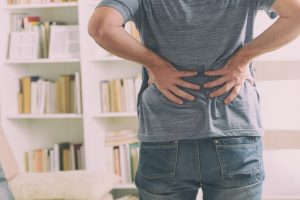
Those who cope with their back pain best stay active and avoid letting the back become stiff (May, 2010). If you need to rest, then do so, but not for too long. Find a position of ease for yourself, for example, side lying with a pillow between the legs. Try to keep yourself moving every 30 minutes and avoid slouching when sitting in chairs.
Below is a handy list of what to do (and what not to do) to self-manage your lower back pain.
- Don’t stay in the same position for long periods.
- Try heat packs to help manage the pain.
- Do not apply hot water bottles directly to the skin, as you could burn yourself.
- Start gentle exercise straight away.
- Do not smoke. Smoking affects the rate of healing.
- Use the correct technique when you stand up from a seated position. Avoid over-extending the back.
- Seek advice from a physiotherapist if your symptoms are persistent and you aren’t noticing improvements.
Summary
Lower back pain is widespread and can be caused by a multitude of things. It has many forms, most of which are easily remedied. There are many ways to prevent lower back pain. Ensure you stand up now and again if you have a sedentary job. Carry a backpack, not a shoulder bag, and incorporate periods gentler exercise into your workout regime. After you experience lower back pain once, it’s likely it will reoccur. However, it is possible to treat and self-manage lower back pain in most cases.
Prone to injury? If you liked this post, read up on how to prevent common injuries or learn how stretching can help you get stronger.
